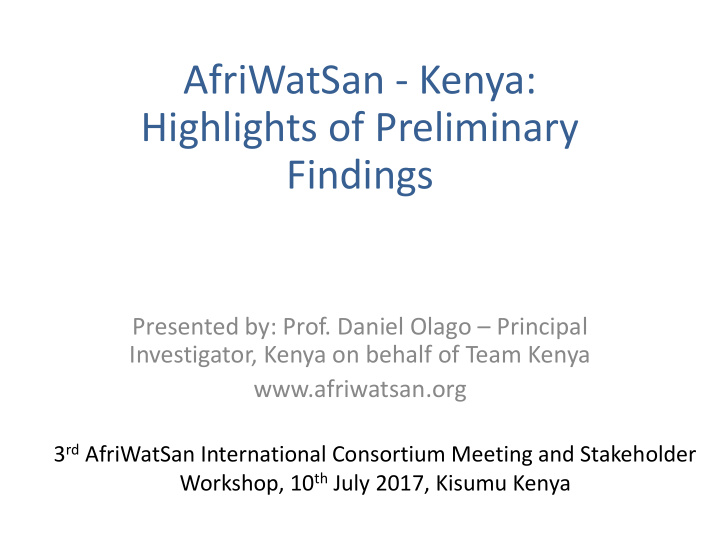



AfriWatSan - Kenya: Highlights of Preliminary Findings Presented by: Prof. Daniel Olago – Principal Investigator, Kenya on behalf of Team Kenya www.afriwatsan.org 3 rd AfriWatSan International Consortium Meeting and Stakeholder Workshop, 10 th July 2017, Kisumu Kenya
Presentation Outline • Introduction to the study sites • The water science • Sanitation • Climate extremes vs water supply • Health • Capacity strengthening • Conclusion
The Study Area
The Water Science - Hydrogeology Revision of existing geological map of Kisumu is ongoing. - More faults to lake, control springs - Groundwater control by Archaean Grit – previously unmapped - Shallow groundwater/springs at phonolite-laterite interface - Nandi Hills recharge
Monitoring Sites for Climate and Groundwater Levels • VES geophysical profiling conducted in fifteen site within the observatory • Nine sites to be selected for piezometer construction and installation of data loggers in August/September 2017 • To measure variations in groundwater level • Weather station to be installed at 3 sites • KIWASCO, WRA and LBDA to be key partners
Kudho Primary School K udho Pri Sch 1000 100 Apparent Resistivity (ohm-m) 10 1 0.1 1 10 100 Spacing (m) INTERPRETATION LAYER RESISTIVITY THICKNESS DEPTH ELEVATION Moist soils 1 125 0.5 0.5 2002 Lateritic 2 240 3.3 3.8 2000 Weathered laterite: water 3 8.9 20.2 24 1980 bearing Highly weathered phonolites 4 12
The Water Science – Chemical Water Quality Monthly physical- chemical data aquisation carried out from December 2016 to June 2017 22 sites - surface water (R. Nyamasaria/Kibos, Lake Victoria), springs (Kudho, Kogweno, Kosinda, Asengo and Kokelo), shallow wells (Nyahera, Lower Kotetni, Upper Otonglo, Mbeme and Kibos) and boreholes (Kokelo, Wandiege and Korumba) Generally potable; nitrate in shallow wells (Kodiaga); high turbidity springs (Kudho); Some F, Fe
The Water Science – Microbiological Water Quality Shallow wells Water samples collected and analysed in the field using contamination higher portable field kit during the during rainy season. scheduled sampling campaign. Deep boreholes clear. Thermotolerant coliform bacteria colonies
Climate Extremes and Water Supply in Informal Settlements • KIWASCO piped water main source of drinking water • During flooding the water may contain suspended matter due to damages to pipes • 25% of the respondents stated the water source for Kiwasco Frequency of potable was not reliable especially water use for drinking during dry spells and heavy rains • 42% say that they have suffered 16% 3% from typhoid and 16% have Always Sometimes suffered from cholera because 20% Rarely 61% of the consumption of piped Other water during rainy season
Sanitation • To map the locations of the dug-wells and the pit latrines in Kisumu City in transect areas • Characterise the facilities by function and technology type. • Determining seasonal physical, chemical and biological quality of water from selected sanitation facilities • Determining current risks and future climate risks on water and sanitation situation in Kisumu City • Developing policy recommendation on the integration of future climate risk forplanning of water and sanitation infrastructure in Kisumu city
Sanitary facitilies in Kisumu Informal settlements
Relating Health Outcomes to Groundwater Government • Civil Society Policies & • Community Capacity • Social Capital Practices • Population Demographics, Urban Slums • SES • Attitudes & Behaviour • Groundwater • Physical Environment Health • Built Environment Services • WatSan Tech Health Outcomes
Relating Health Outcomes to Groundwater • 73% of Kisumu City population has direct water connection from KIWASCO • the 27% not connected to piped water are mainly informal settlements and Kudho Primary School Unprotected Spring areas like Riat Hills • 20% residents have sewer lines connections • 12 years of no cholera outbreak in areas connected with piped water from KIWASCO Kudho Primary School treated water for sale
Relating Health Outcomes to Groundwater
Conclusion • Work progressing well • Geological/hydrogeological model to be completed soon • Socio-economic analysis of household surveys to be completed soon • Monitoring programmes to continue with installation of monitoring sites in next two months • Sanitation and health studies to be ramped up
Recommend
More recommend